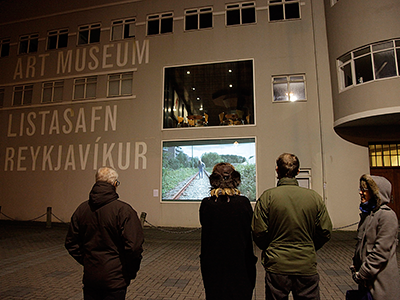Nordic Outbreak visited Reykjavik Art Museum
- Jun 17, 2020
- 3 min read

Nordic Outbreak visited Reykjavik Art Museum between October 25-27, 2013, exploring the theme animated bodies and modified realities. The exhibition program included a screening in the RAM Multispace and a window installation on the facade of RAM to be seen by audience and passersby from the street.
Animated Bodies and Modified Realities, the theme of the Reykjavik program, explores the moving image as a platform for performative investigation and modes of enhancing and creating new realities via the ever advancing modification possibilities of editing tools. The program presents current elements of video art in the Nordic countries with specific emphasis on the recurring threads of video art in Iceland, such as performativity and animation.
The works presented in this selection of Nordic Outbreak offer insight into subjects as varied as spiritual relations between nature and technology, nature as reflected in the internal dimensions of dreams and nature as a victim of human destruction, dark chapters in Nordic history, healing powers of humans and our methods of creating history.
Works by: Eija-Liisa Ahtila (FI), J Tobias Anderson (SE), Jeannette Ehlers (DK), Søren Thilo Funder (DK), Sigurdur Gudjonsson (IS), Styrmr Ørn Gudmundsson (IS), Eeva-Mari Haikala (FI), Iselin Linstad Hauge (NO), Kolbeinn Hugi Höskuldsson (IS), Hannu Karjalainen (FI), Dan Lestander (SE), Una Lorenzen (IS), Pernille With Madsen (DK), Dodda Maggy (IS), Miia Rinne (FI), Magnus Sigurdarson (IS), QNQ/AUJIK (SE)
As something special, the Reykjavik program presents five new video works by local Iceandic artist:
Kolbeinn Hugi Höskuldsson, Plato’s Dream of Atlantis as Seen by the Great Edgar Cayce (2013) Styrmr Ørn Gudmundsson, Second Level (2013) Sigurdur Gudjonsson, Balance (2013) and EDDA (2013) Dodda Maggý, There, There (2013)
The opening night included talks by Tanya Toft on the Nordic Outbreak exhibition project and New York-based Streaming Museum as a digital/public space exhibition structure, and by curator and theorist Jonatan Habib Engqvist on the history of Nordic moving image.
The talk by Jonatan Habib Engqvist was an attempt to sketch a history of moving images and things in the Nordic region. Even if the notion, or image, of “Nordic” can be contested in itself, such a regional genealogy can be a feasible means to reinstate the importance of disregarded people and phenomena particular to the area and, more importantly, to a particular media. By focusing on moving images and things, presenting some stories, anecdotes and myths stemming from early modernity and the 1960´s, this talk will try to say something about their relevance for the current scene in the region and beyond. Finally, the question of what to do with the projected narratives associated to the ”Nordic Thing” will be addressed in a speculative manner, hopefully providing material for further discussion during the Saturday panel at the Reykjavík Art Museum.

Panel, October 26: Video Art : Then & Now
Nordic Outbreak was presented at the Reykjavik Art Museum during the first historical exhibition of Icelandic video art shown in Reykjavik, Icelandic Video Art from 1975-1990 on display at the Reykjavik Art Museum, curated by Margrét Elisabet Ólafsdóttir. A panel was organized in a collaboration between the two exhibitions, which simultaneously raises questions about the role of local histories and their relevance in regard to contemporary video art practices.
The speakers included Jacob Lillemose (curator), Jonathan Habib Engqvist (curator), Hlynur Helgason (assistant professor at the University of Iceland) and Dodda Maggý (artist). The panel was moderated by Margrét Elísabet Ólafsdóttir (independant researcher at The Reykjavík Academy), curator of the exhibition Icelandic Video art from 1975 to 1990.
Nordic Outbreak in Reykjavik was a program of Streaming Museum and is presented in collaboration with the Reykjavik Art Museum. The two screening programs, including a selection of artwork from the Nordic Outbreak exhibition, were curated by Birta Gudjonsdottir and Tanya Toft. The exhibition was supported by the Icelandic Art Center.
Photography: Ingvar Högni Ragnarsson. More documentation from Nordic Outbreak – Reykjavik here.















